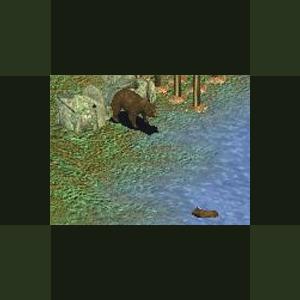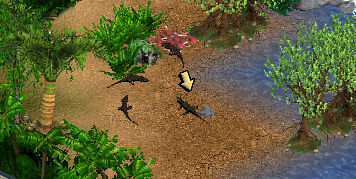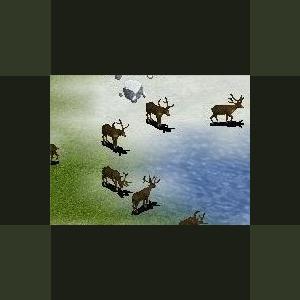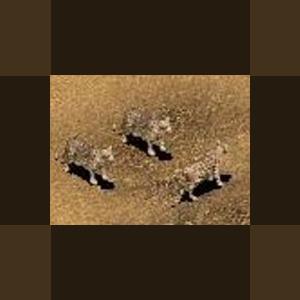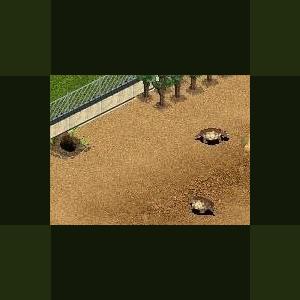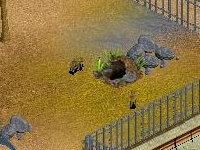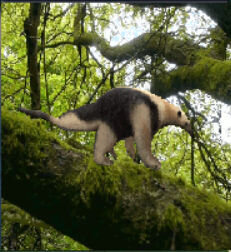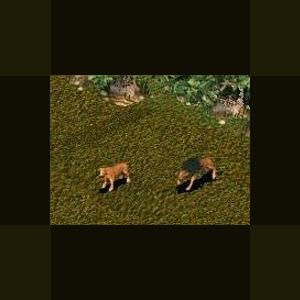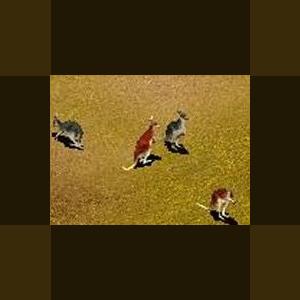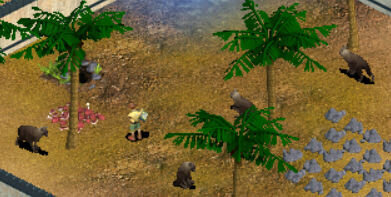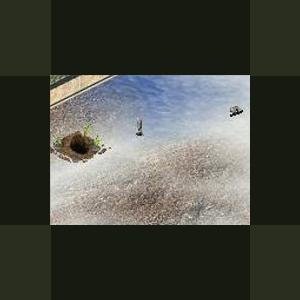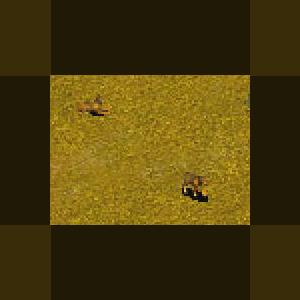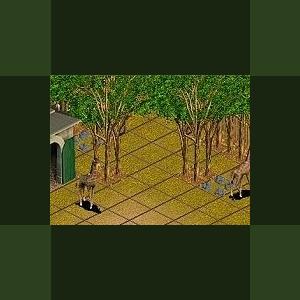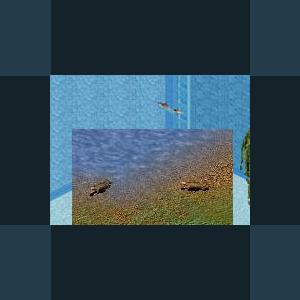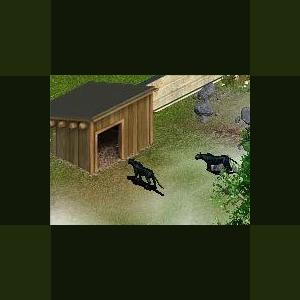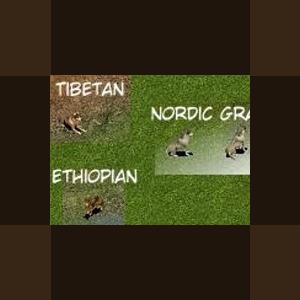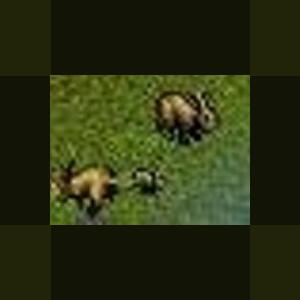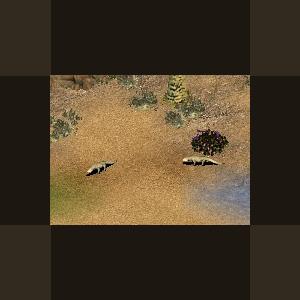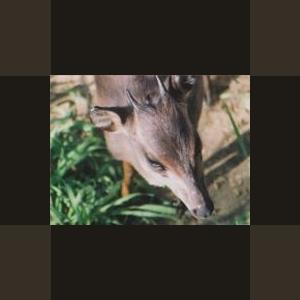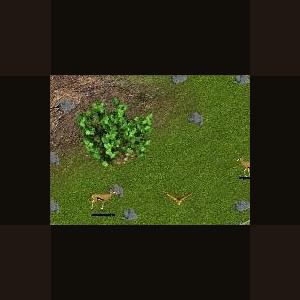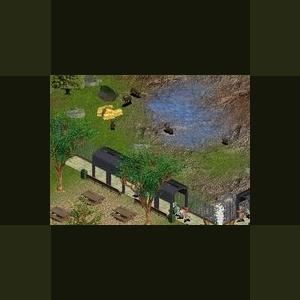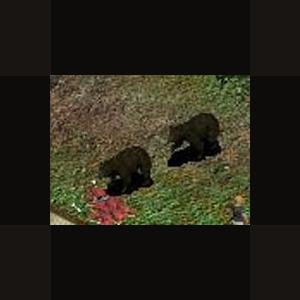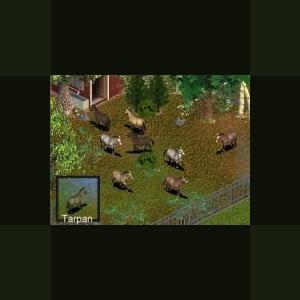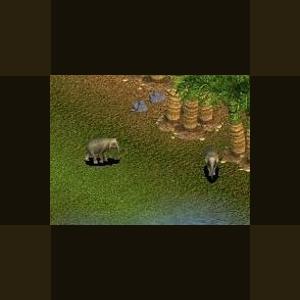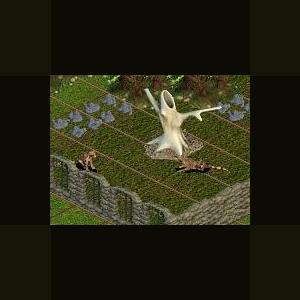279 files
-
Kodiak Bear by Ghirin
By Guest
Kodiak Bear
The Kodiak bear (Ursus arctos middendorffi) is the largest subspecies of brown bear and the second largest carnivore in the world (second only to the polar bear). Mature boars (males) can reach 1500 pounds in weight, while mature females can reach up to 750 pounds. Male shoulder heights have been recorded up to 5 feet with standing heights up to 10 feet.
This unique bear is native only to the islands the Kodiak Archipelago, including Kodiak, Shuyak, and Afognak, and have been isolated from other brown bears for about 12,000 years. The current population is between 2800 to 3000 bears.
Even though they are classified as carnivores, Kodiak bears are actually omnivorous, eating a variety of foods and concentrating on what foods are in season. They eat a number of plant foods such as grasses, sedges, and berries when the the plants are most nutritous. Eggs, nestlings and salmon are also valued as rich sources of nutrition and a source of fat for winter hibernation.
Created by Ghirin 2003
Updated 2010-11-03
Just to save space with less in zip and smaller image.
Nothing new.
448 downloads
0 comments
Updated
-
Rough Neck Monitor by Khaydar
By Khaydar
Thanks for downloading the rough neck monitor lizard. Lives on mangroves alone or in small groups
238 downloads
Updated
-
Barren Ground Caribou by Ghirin
By Guest
Barren-ground Caribou
Author: Ghirin
The barren-ground caribou (Rangifer tarandus granti and Rangifer tarandus groenlandicus) are one of the three varieties of North American caribou. (The other varieties are woodland and Peary.) The Alaskan subspecies (R. t. granti) lives west of the Mackenzie River, while the Canadian subspecies (R. t. groenlandicus) lives east of that river. The name "barren-ground" refers to the artic tundra that these animals live on.
Barren ground caribou are known for their tendency to form large, migrating herds. During the spring and summer months, barren-ground caribou migrate to their calving grounds in the high arctic. They then migrate to southern lands to avoid the harsh winter.
Like other caribou, barren-ground caribou are vegetarians, feeding on young leaves, lichens, grasses, and sedges. When the ground in covered with snow, they will scrape the snow aside with their hooves. This behavior has given the animals their name, derived from the Mi'kmaq term "xalibu" meaning "one who paws".
Created by Ghirin 2004
Updated 2010-10-30
Just to save space with less in zip and smaller image.
Nothing new.
532 downloads
0 comments
Updated
-
Persian Leopard by Moondawg
By Guest
Persian Leopard
The Persian leopard (Panthera pardus saxicolor), or Iranian leopard, is one of the leopard subspecies native to western Asia. It is endangered throughout its range in the Middle East.
The Persian leopard is said to be the largest of all the subspecies of leopards in the world. It can grow to up to 1.5 to 2.7 feet tall at the shoulder, and weigh as much as 155 lbs. Before 1990, when Armenia, Azerbaijan, Georgia, Russia, and Turkmenistan were the Soviet republics, the scientific names of the leopard used in these countries were P.p. tulliana and P.p. ciscaucasica, whereas the name P.p. saxicolor had been traditionally used by the western specialists for the cats in Iran and, partially, Afghanistan. There are currently a few hundred left in the world.
It is found in Iran, Azerbaijan, Armenia, Turkmenistan, Uzbekistan, Tajikistan, and northwestern Afghanistan. Habitat varies from mountain steppe to grasslands, or anywhere having a reasonable amount of cover and a supply of prey. Unconfirmed reports of big cats in the far southeast of Turkey might also pertain to these animals; see the Caspian Tiger article for details.
Updated 2010-11-05
Just to save space with less in zip and smaller image.
Nothing new.
488 downloads
0 comments
Updated
-
Desert Tortoise by Jordan
By Guest
The desert tortoise is a small reptile found in the Mojave and Sonoran Deserts of southeastern California, southern Nevada and south through Arizona into Mexico.
Updated 2010-10-30
Just to save space with less in zip and smaller image.
Nothing new.
408 downloads
0 comments
Updated
-
Asian Ruppel's Fox (Sand Fox) by Ghirin
By Guest
Asian Ruppell´s Fox By Ghirin
The sand fox (Vulpes ruppelli), also known as Ruppell's fox, is native to arid and semi-arid regions in northern Africa, Arabia and central Asia, including stony desert, steppes, thornbush savannah, and dry woodland. They have a distinctive call, a "wow" sound ending in two yaps.
Sand foxes live in pairs or small family groups. They build dens, but also tend to move to a new location about once a week. Sand foxes hunt at night, preying on small mammals, insects, fruit and carrion.
Created by Ghirin 2004
Updated 2010-10-30
Just to save space with less in zip and smaller image.
Nothing new.
Updated August 18, 2018 by Cricket so that screenshot would show up again.
356 downloads
0 comments
Updated
-
Southern Anteater by Khaydar
By Khaydar
Adopt a Southern Anteater (Tamandua tetradactyla) for your zoos.
Southern Anteater description:
Cannot be used in original Zoo Tycoon: Requires DD
Minimum happiness needed for chance of breeding: 95.
Liked foliage:
Ulmo Tree, Llala Palm Tree, Kapok Tree
Animal can climb objects.
Animal can climb cliff.
Number of animals allowed per exhibit: 1-3 with 15 squares each.
A suitable exhibit for 2 of this animal has 30 squares containing terrain of:
24 Rainforest Floor, 2 Grass, 3 Dirt, 1 Fresh Water
using 4 grid squares filled with 4 Ulmo Tree most liked plant
and using no rocks.
Preferred shelter: Large Burrow.
Credits to Hendrix and Zerosvalmont for the model and mesh
Made by Khaydar
217 downloads
- living animal
- anteater
- (and 1 more)
Updated
-
Rose Lion by Ghirin
By Guest
The rose lion is a fantastic animal native to the broadleaf forests of Asia. This lion's unique fur color makes it a zoo favorite.
Created by Ghirin 2007
Updated 2010-11-05
Just to save space with less in zip and smaller image.
Nothing new.
327 downloads
0 comments
Updated
-
Dimorphic Red Kangaroo by Ghirin
By Guest
Dimorphic Red Kangaroo
Author: Ghirin
Red kangaroos are the world's largest marsupials. Despite the name, not all red kangaroos are red. In the eastern part of their range, males are usually some shade of red and females are blue-gray; elsewhere, both sexes may be reddish brown. Male kangaroos are called "boomers," female kangaroos are "blue fliers," and young are called "joeys." Red kangaroos are found primarily in the dry grasslands and plains of central Australia. The terrain in this region consists of savannah-like grasses interspersed with barren areas of dry dirt, sand, and the occasional rock. Kangaroos prefer open areas, with a sparse scattering of native bushes and trees for shade. Kangaroos are semi-nomadic, and their movements are not restricted by most types of fencing.
These animals congregate in loose and temporary social groupings, called mobs. Although the makeup of a mob can vary, it will commonly contain a dominant male, several adult females, and young of both sexes. Mothers and young can remain together for years.
Kangaroos are able to survive high temperatures by seeking shade during the day and feeding at night. In the wild, their diet consists of green grass, leaves, and roots. They swallow their food whole, later regurgitating a cud and chewing it. In the wild, this animal does not need continual access to fresh water, as long as green herbage is available. When necessary, they will dig for water. In zoos, kangaroos are fed a diet that typically includes fruit, yams, bread, monkey-dog-guinea pig chow, and vitamin supplements.
Baby kangaroos are bean-sized when born. The tiny, hairless embryo makes its way across the mother's belly into the pouch, where it attaches itself to one of the four available teats. Once nursing begins, the teat swells up so that the baby will remain attached. The joey will remain in the pouch for 5 to 6 months as it continues to mature. After that, it will be fully developed and can emerge to explore. Joeys are usually weaned around one year of age, but will remain close to the mother for another six months.
Kangaroos are so well-designed for hopping that they are unable to walk. They have large, powerful hind feet that cannot move independently of each other and a tendon in their legs that behaves like a rubber band, conserving energy as they move. Red kangaroos can hop as fast as 40 mph, making leaps as long as 29 feet. Kangaroos will run from danger, rather than fight, although a large claw attached to their hind leg makes them quite dangerous at close quarters. The kangaroo's long, heavy tail provides balance and support.
Red kangaroos are shy, alert creatures, docile except when cornered. To warn their mob of impending danger, these animals will thump on the ground. Hearing this warning, joeys will jump back into their mothers' pouches. Although males will not defend the members of their mob from attack, they will fight each other for breeding rights. The two boomers will attempt to push each other off balance by jabbing or locking forearms. Sometimes they will lean back on their tails and kick each other in the belly with their powerful hind feet.
Foxes and eagles prey on very young kangaroos. Dingoes prey on young and adult alike. Because of the damage they can do to crops, kangaroos are considered pests and are destroyed accordingly. Red kangaroos are also commercially hunted for skins and meat. This animal is considered a threatened species.
Updated 2010-10-30
Just to save space with less in zip and smaller image.
Nothing new.
341 downloads
Updated
-
Brown Hyena by Khaydar
By Khaydar
Adopt a Brown Hyena (Hyaena brunnea) for your zoos.
Animal guide:
Minimum happiness needed for chance of breeding: 90.
Liked foliage:
Savannah foliage, desert foliage
Liked rock:
Savannah rocks, desert rocks, small, medium, large rocks
Animal can jump.
Number of animals allowed per exhibit: 2-8 with 20 squares each.
A suitable exhibit for 2 of this animal has 40 squares containing terrain of:
18 Sand, 8 Savannah Grass, 4 Dirt, 8 Brown Stone, 2 Fresh Water
using 2 grid squares filled with 4 Palm Tree most liked plant
and using 16 Small Rock - Small most liked rock.
Of the 40 squares, 1 nonadjacent squares should be elevated.
Preferred shelter: Large Burrow.
Updated: 19 January 2021 by fern to change the ztd and zip names (to avoid a file name conflict), and to compress the ztd better. None of the files inside the ztd were changed.
213 downloads
- living animal
- khaydars animal
- (and 1 more)
0 comments
Updated
-
Ermine by Jordan
By Guest
The Ermine, also known as a stoat when not in its winter coat, is found in temperate and arctic regions throughout the northern hemisphere and is a member of the weasel family.
Updated 2010-11-03
Just to save space with less in zip and smaller image.
Nothing new.
481 downloads
0 comments
Updated
-
Bengal Fox by Ghirin
By Guest
The Bengal fox (Vulpes bengalensis), also known as the Indian fox, is the common fox of the Indian subcontinent. This fox is medium-sized and is a distinctive buff to sandy orange color. It lives in semi-arid regions, open grasslands, and lightly forested areas. The fox has been reported at elevations up to 1350 meters.
Even though Bengal foxes live in monogamous pairs, each fox hunts alone. The usual prey items include small mammals, ground nesting birds, and insects. They will also eat fruits in season.
Bengal foxes dig two types of dens: simple short ones for brief periods of rest and complex, cavernous ones with many entrances.
*Inspired by the Zoo Tycoon Brains Trust(http://www.geocities.com/professorpaul1/home.html)
Created by Ghirin 2003
Updated 2010-10-30
Just to save space with less in zip and smaller image.
379 downloads
0 comments
Updated
-
Rothschild Giraffe by Coolperson5
By Guest
This Giraffe is a critically endangered subspecies from Kenya and Uganda.
Updated 2010-11-05
Just to save space with less in zip and smaller image.
Nothing new.
425 downloads
Updated
-
European Otter by BigCatKeeper
By Guest
European Otter
Author: BigCatKeeper
http://www.zoo-tek.com/forums/index.php?download=161
With the exception of the fox and wildcat all British carnivores belong to the family known as mustelids (the weasel family) of which there are 8 member species in the UK. All tend to be characterised by long sinuous bodies and short legs (the powerful build of the badger is an exception to this, but this animal is highly distinctive because of its facial strips and size).
The Otter is a secretive semi-aquatic member of the mustelid family, once widespread in Britain where it was found living on rivers and inland waterways and in certain coastal areas.
In the late 1950's and early 1960's pollution, hunting and loss of habitat caused a serious decline in the otter population, not only here in Britain but throughout Europe.
Today, with strict protection from the Wildlife and Countryside Act anti-pollution laws resulting in cleaner rivers, and river banks environmentally managed to provide secluded undisturbed habitats, the otter population is once again on the increase with many sightings in their former habitats.
Otters in the wild are extremely shy and rarely seen. During the day they tend to lie up in suitable cover on the river bank only becoming active at dawn and dusk when riverbanks and waterways are at their quietest, allowing them to hunt for food undisturbed.
Fish make up the greater part of an otter's diet with eels being a particular favourite, but they will also take water fowl, moorhens, coots and ducks and anything else that is edible living along the riverbank.
European Otter created by Bigcatkeeper
Thanks to Professorpaul
Updated 2010-11-03
Just to save space with less in zip and smaller image.
Nothing new
480 downloads
0 comments
Updated
-
Black Puma by LAwebTek
By Guest
Black Puma
Author: LAwebTek
Black (Melanistic) pumas, also known as cougar, panther, mountain lion, night screamer, catamount, mountain devil, and king cat, are not a separate subspecies of puma, but rather a color variation within the species. Black pumas are extremely rare to the extent that no one has ever captured one and placed it in captivity. There are very few photographs or sightings of the black puma, although clearly enough to prove that the animal does exist and is not a myth as was once believed.
Black pumas are believed to reside primarily in Canada and the northern most parts of the United States. The black color is an adaptation to the colder climate, while pumas in most of North and South America have a redish-brown color. The black puma's ideal habitat is mountainous forests up to 16,000 feet. Pumas are very territorial and mark their territory. They are carnivores that are active both day and night and their prey consists of a variety of mammals, birds and fish. If larger animals such as white-tail deer, caribou and moose are not available, the puma is able to adapt quickly and switch to smaller prey such as raccoon, skunk, birds and fish. If hungry enough, the puma will even take down horses, cows, and other livestock and so it has a bad reputation by farmers.
Black pumas can range in weight from about 150 lbs. to 200 lbs, the male is larger than the female. Their tail can be almost as long as their body length and is used for balance. Using sight and sound more then scent, the puma stalks its prey. Their back legs are more developed than their front legs which allows them to ambush prey and jump on their backs to go in for the kill. Pumas have the ability to leap an incredible 40 feet. The strong muscle development in the back also enables the puma to maneuver in the more difficult mountainous areas and steep ravines. When hunting, the puma grips into the victims neck and either snaps the prey's neck or grips into the windpipe until it suffocates. After the puma kills its victim, it will cover it with debris to reduce the risk of other animals finding the carcass and to prolong the food.
Males breed with a large number of females to increase reproductive success. One male will have a very large range and all the females, who have much smaller ranges are resident in the male's territory, will mate with that one male. The male will search for days for the female(s), covering 50 km in a day and night. The puma, who hunts silently, will howl when ready to breed. Pumas do not choose a particular season to mate. The females will mate starting around age two or three and will select a cave or other shelter as a spot for her cubs' birth. One to six cubs may be born, blind and helpless. They gain vision after two weeks. The cubs will grow its parents' muscular jaws, wide gape, and long teeth which are designed to clamp into it's prey, as well as to eat it. While they are cubs, the female will protect and feed them. This will continue until they are about a year and a half old and can defend themselves.
Updated 2010-10-30
Just to save space with less in zip and smaller image.
415 downloads
0 comments
Updated
-
Wolf Pack ll by Jordan and Ryno
By Guest
Three wolves for your zoo:
The Tibetan wolf, Nordic Gray, and Ethiopian wolf
Updated 2010-11-11
Just to save space with less in zip and smaller image.
Nothing new.
345 downloads
0 comments
Updated
-
European Rabbit by Sundance
By Guest
European Rabbit by Sundance
In several parts of the world the European rabbit is known for the damage and depredation. It was introduced into Britain by the Normans, and introduced from there by settlers into Australia and New Zealand.
Once introduced in the wild its numbers increased and livestock pastures and crops were devastated. In Australia, the near extinction of several types of marsupials can be attributed to competition with rabbits. European rabbits can be prolific breeders. One doe can produce up to thirty young in a single breeding season.
works with ZT, DD, MM and CC.
Updated 2010-11-03
Just to save space with less in zip and smaller image.
Nothing new
391 downloads
0 comments
Updated
-
Perentie by Volksdragon
By Guest
Perentie by Volksdragon
Perenties are fairly large Australian lizards in the monitor family.
Perenties are fairly large lizards in the monitor family. They come from the deserts and scrublands of Australia
Updated 2010-11-05
Just to save space with less in zip and smaller image.
Nothing new.
397 downloads
Updated
-
Blue Duiker by Jordan
By Guest
Body Length: 50-75 cm / 1.6-2.5 ft.
Shoulder Height: 30-40 cm / 12-16 in.
Tail Length: 7-10 cm / 3-4 in.
Weight: 3.8-5.4 kg / 8.4-12 lb.
Females are generally larger than males in this duiker species. The colour of the coat varies with the region from slate grey to grey-brown, with a bluish sheen on the back. The underparts, inner legs, rump, and underside of the tail are whitish. There is a light eye-brow ridge which curves up to the base of the horns, as well as a glandular slit underneath the eye. The horns are strongly ridged and short, growing 2-10 cm / 0.8-4 inches long. The horns are sometimes absent in females, or hidden by the short head crest.
Gestation Period: 7.5 months.
Young per Birth: 1, rarely twins.
Weaning: By 5 months.
Sexual Maturity: Females at 9-12 months, males at 12-18 months.
Life span: 10-12 years.
Kids lie concealed away from the mother for 2-3 months. At this point their coat changes from reddish brown to the grey-blue colour of adults.
The blue duiker is mostly active at night and at dawn and dusk. Bonded pairs patrol their territory, which are 2.5-4 hectares in size, regularly marking them with scent clues from their pedal glands (situated between the hooves), facial glands, and from defecating. Both sexes chase off any intruders, but will remain tolerant of their own young until they reach 18 months of age. The mother and young contact through soft groaning calls, both freezing at the slightest alarm. Males may emit a whistle or a sneezing sound to raise the alarm. Population densities of up to78 per square kilometer have been recorded in Gabon.
Family group: Solitary or in mating pairs.
Diet: Leaves, buds, shoots, grasses, fruit, insects, eggs.
Created by Jordan, Zoo Tek Designer, 2005.
*Inspired by the Zoo Tek Nature Encyclopedia. (www.zoo-tek.com)
Updated 2010-10-30
Just to save space with less in zip and smaller image.
370 downloads
0 comments
Updated
-
Pronghorn by Coolperson5
By Guest
Pronghorn by Coolperson5
The Pronghorn is an antelope-like creature of North America. It is a preview for my Grassland Pack
Updated 2010-11-05
Just to save space with less in zip and smaller image.
Nothing new.
368 downloads
0 comments
Updated
-
Alpine Ibex by Paardjee
By Guest
Alpine Ibex by Paardjee
A different species of ibex for in your zoo.
Alpine ibexes are very cheerfull and lively they'll make your guests very happy
The Alpine Ibex (Capra ibex) commonly called by its French name: bouquetin, by its German name: steinbock, by its Dutch name: steenbok, by its Slovenian name: kozorog, or by its Latin nickname: capricorn—is the species of ibex that lives in the European Alps. The Spanish Ibex (Capra pyrenaica) and the Middle Eastern Nubian Ibex (Capra ibex nubiana) are very close relatives of the Alpine Ibex — the Spanish form is generally considered specifically distinct, but the Nubian is usually considered a subspecies of Alpine Ibex.
Habitat
Being an excellent climber, its habitat is the rocky region along the snowline above alpine forests of the European Alps. They tend to occupy steep, rough terrain at elevations of 6,500–15,000 feet.
Appearance
Male specimens commonly grow to a height of about 1 metre (3 feet) and reach a weight of about 100 kg (220 lb). Females are usually only half the size of males. Apart from size, males can also be distinguished by their prominent beard. Older males will tend to grow beards under their chin. Both male and female ibexes have large, backwards-curving horns although those of the male are substantially larger and can grow to an impressive length of up to 1 m. These horns are used to defend themselves from predators such as wolves, lynxes, bears and foxes. Small kids may also be susceptible to attacks from large predatory birds such as eagles. The Ibex has a brownish grey colouring in the summer which changes during the winter months to a richer, darker brown. It is related to the Nubian and Siberian ibexes.
Foraging behaviour
Ibexes are strictly herbivorous and survive on a diet of grass, moss, flowers, leaves and twigs. If leaves and shoots are out of reach, Ibexes often stand on their rear legs to reach this food. They eat during late afternoon and evening hours, descending at this time from the high steep cliffs and into the lower alpine meadows below. The rest of the day is spent in the higher altitude of the cliffs and hills. This pattern of remaining at higher altitudes during the bright daylight hours helps protect them from predators who do not inhabit such high terrain. In the winter, Ibexes also tend to live at lower altitudes since food is more scarce. The need to drink every few days in the summer causes the Ibexes to seek permanent residence within proximity to a dependable water source during this season. If predators are after them, Ibexes will hide in the rocks of the steep cliffs.
Updated 2010-10-30
Just to save space with less in zip and smaller image.
Nothing new.
334 downloads
0 comments
Updated
-
Atlas Bear by Ghirin
By Guest
Atlas Bear by Ghirin
The Atlas bear was the only species of modern bear to live in Africa. It was native to the forests of North Africa and was thought to be a sub-species of the brown bear (Ursus arctos crowtheri). The Atlas bear was smaller than most brown bears and closer in size to the North American black bear.
The Atlas bear was believed to be the Libyan bear mentioned by ancient writers and may also have been the Numidian bear used for arena games by the ancient Romans.
The bear's former habitat was the dry forest of North Africa. Most of the North African forest has been cut and this was thought to be the major cause of the bear's extinction. A small population of bears survived in the Atlas Mountains until the 1800s. At that time, the increase in the number of firearms in North Africa led to over-hunting and final extinction of the Atlas bear. The Atlas bear prefers a mixture of coniferous and deciduous forest with some elevation. Source of information and plaque illustration: The Doomsdat Book of Animals by David Day, 1981.
Created by Ghirin, 2003
Updated 2010-10-30
Just to save space with less in zip and smaller image.
Nothing new.
369 downloads
0 comments
Updated
-
European Horses and Forest Tarpan Comb. by Genki and Ghirin
By Guest
Genki's European Horses and Ghirin's Forest Tarpan combined into a single ztd. These 5 horses are 100% compatible, and will be very happy in a shared exhibit.
Forest Tarpan by Ghirin:
The tarpan (Equus caballus gmelini) was the wild horse of Europe and western Asia.
There were two basic types: forest and steppe. The forest tarpan was a bit smaller than its steppe counterpart and darker in color. The tarpan is believed to the ancestor of modern light horse breeds.
The forest tarpan lived in most of Europe, dwelling in the forested areas. It became extinct as farmers converted its habitat to farmland and killed tarpans because tarpan stallions would steal domesticated mares for the wild herds. The original wild tarpan died out in the late 1800s.
Two attempts have been made to reconstruct the tarpan from animals of mixed tarpan and domestic background. In Poland, the government has established a feral herd of horses descended from mixed stock in the forest preserve of Bialowieza. With each generation, this herd seems to display more tarpan-like characteristics. The second attempt was by German zoologists. They used primitive breeds of European horses to produce a tarpan-like horse.
The classic features of the forest tarpan include a mouse-dun color with a black stripe down the center of the back and dark legs, semi-erect mane, large head with massive jaws, a thick neck, and tough hooves that do not need to be shod.
Created by Ghirin 2003
Updated 2010-11-03
Just to save space with less in zip and smaller image.
Nothing new
405 downloads
0 comments
Updated
-
Sumatran Elephant by Jordan
By Guest
Sumatran elephants are the smallest of the Asian elephants. Males rarely develop long tusks, while those of adult females may be so short that they are hidden by the upper lip. This elephant can live up to 70 years in captivity, less in the wild.
The endangered Sumatran elephant (Elephas maximus sumatranus) is the smallest (and perhaps oldest) of the Asian subspecies and is unique to the island of Sumatra. It has been protected in Indonesia since 1931. Population surveys conducted in the 1980’s estimated that only 2800 – 4500 wild elephants remained. It is likely that even fewer survive in today’s fragmented forests. The term "pocket elephants" was originally coined to refer to their diminutive size, and also reflects their survival today in the few remaining "pockets" of lowland rainforest.
The combined effects of road development, logging, conversion of forest to agriculture, and human resettlement have contributed to the loss of thousands of hectares of elephant habitat. As habitat shrinks, elephants are forced into conflict with humans. The destruction of crops and houses results in injuries and deaths of both humans and elephants.
Villagers faced with raiding elephants demanded that the government resolve the problem. To these villagers, the elephants were just dangerous crop-raiding pests. Occasionally, angry villagers have poisoned elephants. Unlike other Asian countries, with strong elephant traditions, elephants are not revered in Indonesia.
The government of Indonesia began establishing Elephant Centers on Sumatra in 1986 in an attempt to relieve human-elephant conflicts. Today there are six Centers that hold approximately 400 elephants.
Updated 2010-11-06
Just to save space with less in zip and smaller image.
Nothing new.
366 downloads
0 comments
Updated
-
Bornean Clouded Leopard by Coolperson5
By Guest
The Bornean Clouded Leopard is a recently discovered species originally thought to be a subspecies of the mainland clouded leopard.It lives on Borneo and Sumatra
Updated 2010-10-30
Just to save space with less in zip and smaller image.
532 downloads
0 comments
Updated

